澳门科技大学西方文化通论课本目录检索及课后答案
- 格式:docx
- 大小:39.15 KB
- 文档页数:12
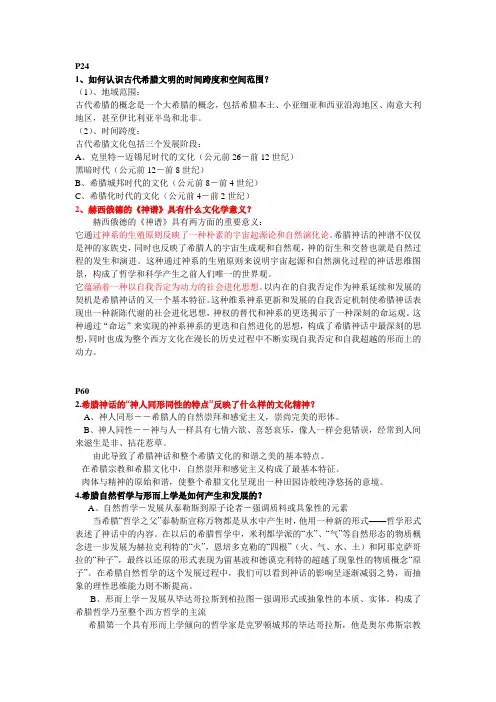
P241、如何认识古代希腊文明的时间跨度和空间范围?(1)、地域范围:古代希腊的概念是一个大希腊的概念,包括希腊本土、小亚细亚和西亚沿海地区、南意大利地区,甚至伊比利亚半岛和北非。
(2)、时间跨度:古代希腊文化包括三个发展阶段:A、克里特-迈锡尼时代的文化(公元前26-前12世纪)黑暗时代(公元前12-前8世纪)B、希腊城邦时代的文化(公元前8-前4世纪)C、希腊化时代的文化(公元前4-前2世纪)2、赫西俄德的《神谱》具有什么文化学意义?赫西俄德的《神谱》具有两方面的重要意义:它通过神系的生殖原则反映了一种朴素的宇宙起源论和自然演化论。
希腊神话的神谱不仅仅是神的家族史,同时也反映了希腊人的宇宙生成观和自然观,神的衍生和交替也就是自然过程的发生和演进。
这种通过神系的生殖原则来说明宇宙起源和自然演化过程的神话思维图景,构成了哲学和科学产生之前人们唯一的世界观。
它蕴涵着一种以自我否定为动力的社会进化思想。
以内在的自我否定作为神系延续和发展的契机是希腊神话的又一个基本特征。
这种维系神系更新和发展的自我否定机制使希腊神话表现出一种新陈代谢的社会进化思想,神权的替代和神系的更迭揭示了一种深刻的命运观。
这种通过“命运”来实现的神系神系的更迭和自然进化的思想,构成了希腊神话中最深刻的思想,同时也成为整个西方文化在漫长的历史过程中不断实现自我否定和自我超越的形而上的动力。
P602.希腊神话的“神人同形同性的特点”反映了什么样的文化精神?A、神人同形--希腊人的自然崇拜和感觉主义,崇尚完美的形体。
B、神人同性--神与人一样具有七情六欲、喜怒哀乐,像人一样会犯错误,经常到人间来滋生是非、拈花惹草。
由此导致了希腊神话和整个希腊文化的和谐之美的基本特点。
在希腊宗教和希腊文化中,自然崇拜和感觉主义构成了最基本特征。
肉体与精神的原始和谐,使整个希腊文化呈现出一种田园诗般纯净悠扬的意境。
4.希腊自然哲学与形而上学是如何产生和发展的?A、自然哲学-发展从泰勒斯到原子论者-强调质料或具象性的元素当希腊“哲学之父”泰勒斯宣称万物都是从水中产生时,他用一种新的形式——哲学形式表述了神话中的内容。

西方文化导论课后习题答案(优.选)(1) Give a brief account of the major achievements of Greek culture, such as those in religion, philosophy, literature and science.Greek religion really took shape during the Homeric Age and featured polytheism with gods taking human form and feeling. Greek religion made a great contribution to Greek literature, philosophy and art. It is an important origin of Greek mythology which was fully developed by the religious tales of the Homeric epic and thus affected the later development of all kinds of Greek culture.Greek philosophy started with Thales (640 BC–547 BC) who believed that the material world originated in water. His philosophy was materialism. He was followed by Pythagoras who assumed that the key to the understanding of the world is numbers, on the opposition of the spokesman for idealism.The core Greek philosophers are Socrates, Plato and Aristotle. Socrates had scant regard for material wealth, but was keen on probing into the definition of some ethical and behavioral issues, such as “friendship”and “courage”.Plato established the Academy -the first Greek institution of higher learning. His contributions included his theory of ideas and his arguments on “republic”which was supposed to embrace his ideals about a future state where humans could enjoy a happy life. Aristotle is also a learned man and his work covers wide-ranging areas. His reputation as a philosopher largely depends on his argument on metaphysics which he tried to achieve a compromise between matter and divinity. Literary representation centred round the two epic poems of the Iliad andthe Odyssey, lyrical poetry by Sappho and Pindar and drama by Aeschylus, Euripides and Aristophanes. Their works combined Greek myths and social life and won much appreciation and enthusiasm from the public.In science the mathematician Euclid established plane geometry and Archimedes discovered the ratio of radius of a circle and the relationship between the volume and surface of a sphere.(2) What do you think of the influence Greek culture has exerted on Western civilization as a whole? Give examples.Greek culture is often termed the cradle of the Western civilization and has had an enormous impact on Western culture. The specific contributions are found in the areas of philosophy, politics, literature, art, science and architecture.Greek politics was one of the greatest influences on the Western civilization. The Greeks were the first to successfully create a government based on the consensus of the people and thus provided a foundation for Western democracy.The second significant influence was that of philosophy. The Socratic idea about ethics and knowledge helped the Westerners care more for the effect of knowledge and value of morality, both of which give sound guidance to people in the later years to improve and change the world outside themselves, i.e., human society and the natural world.Later generations of Westerners have benefited a lot from Greek culture, such as those in painting, sculpture, architecture, drama, poetry and historical works. Classicism had Greek culture as one of the crucial sources, and this has helped Westerners so much that they ascribed the origin of the Renaissance to it. This changed the intellectual conditions of the later medieval periodand opened the way to the modern era in the West.Chapter 21. Tell briefly the major characteristics and contributions of Roman culture, as are demonstrated in religion, poetry, history and architecture.In the early period, Roman culture often depended heavily on the introduction and imitation of other cultures, particularly, Greek culture. Thus Romans created their own powerful culture, laying the foundation for subsequent Western culture in many fields. According to Greek culture and others’ culture; they created their own gods and myth, In poetry, ancient Rome made brilliant achievements,Livy was responsible for the great History of Rome in 142 volumes. His work has always been cited by later statesmen, writers or scholars,The architecture of Ancient Rome adopted the Greek style for its own purposes, but the Romans also developeda new kind.2. In what sense do you think Roman culture owed its accomplishments to the benefits obtained from Greek culture? Give examples.Roman culture learned and inherited a lot from Greek culture.,religion, philosophy and literature. In religion, Rome had its own system of beliefs which had been simple and could hardly compare with the plurality of Greek religion. The same is true of Roman philosophy where we could find examples ,In literature, Roman men of letters also borrowed a All in all, the two cultures are closely linkedgreat deal from Greek culture.Chapter 31. How was the Jewish civilization developed after a tortuous history of split and unification? The major explanation for thedevelopment of the Jewish civilization is its strong cohesiveness and vitality,they put into effect their Judaist beliefs and what they read of Judaist scriptures.From then on Jews have begun to become aware of the necessicity to liberate themselves from the restrictive laws and acquire new knowledge and modern ideas from the Europeans, Most of Jews thus received a good education, fully armed with cultural and scientific knowledge and did well in their own position they could quickly turn it into a well developed nation in spite of its small size and small population .2.Say something about Judaism and The Old Testament.The Old Testament is the Judaist Bible. It was written in Hebrew, including the three parts:Pentateuch, Prophets and Hagiographa and Apocrypha. After The Old Testament was translated into Greek by Jewish scholars,many westerners began to understand Judaism by reading this book. It is not only of religious value but also of literatry value.Chapter 41. What are the main components of Christianity and why could it be accepted as the official religion first by the Roman Empire and then by the following kingdoms or empires in Europe?(1)The main components of Christianity are :1) The Bible as the only Christian scripture;Major Christian doctrines about Trinity and Redemption;3) Other doctrines or events of Christianity:(2 )Christianity is accepted and popular in Europe because of these factors:1).For the common people in the empire ,they needed something to fill up their spiritual vacuum. Christianity could play such a role.2). It could work together with any secular regimes to offer necessary assistance.3). The name and influence of Christiaity would be a symbol of sacredness and justification,4) Christianity is also a kind of culture, it could be tolerated because their life and propertycould thus be secured in the changed circumstances.2. What are the basic differences between Christianity and Judaism?In spite of the fact that the two religions derived from Jewish culture, there are some basic differences between them.First is the different image of God.Second is different view of God. Jehovah is viewed He is like fire or wind .God is kinder and more helpful, Third is the different position each religion is located in and hence would make different contribution. Fourth is Jehovah was important to Jews only in theory and affect them in spirit occasionally while Christianity moved into secular life for the Westerner as Pope and churches became very powerful .Chapter 61.Tell simply the background and development of the Renaissance.It was no accident that it first occurred in Florence and Italy where the early signs of capitalism had appeared at the same time as social chaos, political disputes and military clashes , more and more people began to suspect the justification for those who held the power,Painting and sculpture were the first area to reflect the change of subjects and tastes.(2) What are the major features and achievements of the Renaissance? Give examples.The Renaissance is characterised by seeking ideologicalemancipation, intellectual freedom and political awareness, based on cultural production and religious reformation. All these were undertaken or unfolded gradually but widely, extending its influences to every corner of Europe, with more and more people getting involved.The achievements were seen principally in six areas, namely, painting, sculpture, poetry, fiction, drama and religious reformation as well as the change in the cultural and intellectual climate. Instances could be located in these areas, such as the huge change of subjects and styles in painting. The medieval painting used to centre on depicting Jesus Christ and other Christian subjects, not only effecting similar and the limited subject matter, but also depicting stylistically facial expressions and manners. The great artists in the Renaissance started to focus on the images with individualistic temperament, highlighting humanity instead of divinity, thus breaking away from the medieval frozen models and linking classicalism with human nature as the centre of their representational work.最新文件---------------- 仅供参考--------------------已改成word文本--------------------- 方便更改。

西方文明通论考试答案2017年12月我的答案:√4西方古代宗教建筑体现了人与神的关系。
()(1.0分)1.0分我的答案:√5浪漫主义是高度崇尚感性,排斥理性的。
()(1.0分)1.0分我的答案:√6升华和宣泄是弗洛伊德常用的两个心理学术语。
()(1.0分)1.0分我的答案:√7成功的公共艺术是个性的共鸣反应。
()(1.0分)1.0分我的答案:√8作品《塞基洛斯的墓志铭》的旋律是单旋律。
()(1.0分)1.0分我的答案:√9现代民主的特征体现为是以民族国家为背景。
()(1.0分)1.0分我的答案:√10基督教对于宪政革命带来了全新的世俗权力结构。
()(1.0分)1.0分我的答案:√11不净观是五停心观之一。
()(1.0分)1.0分我的答案:√12政客与政治家不同,前者是个贬义词。
()(1.0分)1.0分我的答案:√13巴洛克时期的器乐和声乐并驾齐驱,分庭抗礼。
()(1.0分)0.0分我的答案:×14美国对内部共同体施行的是契约主义。
()(1.0分)1.0分我的答案:√15洛克认为自由三要素分别是守法、法律未禁止则不受干预、法律由最高统治者制定。
()(1.0分)1.0分我的答案:×16古希腊时期西方的主流思想是以亚里士多德为主的理性主义。
()(1.0分)1.0分我的答案:×17同样一个制度面对不同人的时候发挥的效用不同。
()(1.0分)1.0分我的答案:√18据统计,最伟大的哲学家往往不会出现在德语地区。
()(1.0分)1.0分我的答案:×19基督教认为国家是对罪的惩罚和补救。
()(1.0分)1.0分我的答案:√20公共艺术是追求永恒的艺术。
()(1.0分)1.0分我的答案:√21在美国把印第安人成为First nation。
()(1.0分)1.0分我的答案:×22西方文明是促使国家与文明走向现代化发展道路的第一冲击力。
()(1.0分)1.0分我的答案:√23“德赛”两先生是在新文化运动时期来到中国的。
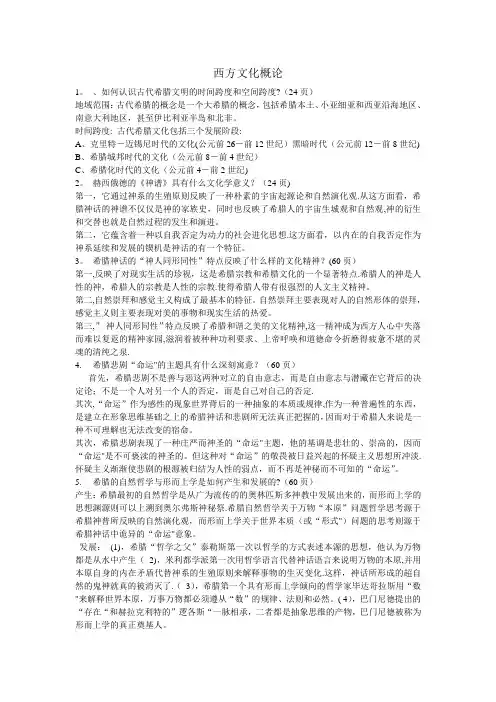
西方文化概论1。
、如何认识古代希腊文明的时间跨度和空间跨度?(24页)地域范围:古代希腊的概念是一个大希腊的概念,包括希腊本土、小亚细亚和西亚沿海地区、南意大利地区,甚至伊比利亚半岛和北非。
时间跨度: 古代希腊文化包括三个发展阶段:A、克里特-迈锡尼时代的文化(公元前26-前12世纪)黑暗时代(公元前12-前8世纪)B、希腊城邦时代的文化(公元前8-前4世纪)C、希腊化时代的文化(公元前4-前2世纪)2。
赫西俄德的《神谱》具有什么文化学意义?(24页)第一,它通过神系的生殖原则反映了一种朴素的宇宙起源论和自然演化观.从这方面看,希腊神话的神谱不仅仅是神的家族史,同时也反映了希腊人的宇宙生城观和自然观,神的衍生和交替也就是自然过程的发生和演进。
第二,它蕴含着一种以自我否定为动力的社会进化思想.这方面看,以内在的自我否定作为神系延续和发展的锲机是神话的有一个特征。
3。
希腊神话的“神人同形同性”特点反映了什么样的文化精神?(60页)第一,反映了对现实生活的珍视,这是希腊宗教和希腊文化的一个显著特点.希腊人的神是人性的神,希腊人的宗教是人性的宗教.使得希腊人带有很强烈的人文主义精神。
第二,自然崇拜和感觉主义构成了最基本的特征。
自然崇拜主要表现对人的自然形体的崇拜,感觉主义则主要表现对美的事物和现实生活的热爱。
第三,”神人同形同性”特点反映了希腊和谐之美的文化精神,这一精神成为西方人心中失落而难以复返的精神家园,滋润着被种种功利要求、上帝呼唤和道德命令折磨得疲惫不堪的灵魂的清纯之泉.4. 希腊悲剧“命运"的主题具有什么深刻寓意?(60页)首先,希腊悲剧不是善与恶这两种对立的自由意志,而是自由意志与潜藏在它背后的决定论;不是一个人对另一个人的否定,而是自己对自己的否定.其次,“命运”作为感性的现象世界背后的一种抽象的本质或规律,作为一种普遍性的东西,是建立在形象思维基础之上的希腊神话和悲剧所无法真正把握的,因而对于希腊人来说是一种不可理解也无法改变的宿命。

西方文化概论1。
、如何认识古代希腊文明的时间跨度和空间跨度?(24页)地域范围:古代希腊的概念是一个大希腊的概念,包括希腊本土、小亚细亚和西亚沿海地区、南意大利地区,甚至伊比利亚半岛和北非。
时间跨度: 古代希腊文化包括三个发展阶段:A、克里特-迈锡尼时代的文化(公元前26-前12世纪)黑暗时代(公元前12-前8世纪)B、希腊城邦时代的文化(公元前8-前4世纪)C、希腊化时代的文化(公元前4-前2世纪)2。
赫西俄德的《神谱》具有什么文化学意义?(24页)第一,它通过神系的生殖原则反映了一种朴素的宇宙起源论和自然演化观.从这方面看,希腊神话的神谱不仅仅是神的家族史,同时也反映了希腊人的宇宙生城观和自然观,神的衍生和交替也就是自然过程的发生和演进。
第二,它蕴含着一种以自我否定为动力的社会进化思想.这方面看,以内在的自我否定作为神系延续和发展的锲机是神话的有一个特征。
3。
希腊神话的“神人同形同性”特点反映了什么样的文化精神?(60页)第一,反映了对现实生活的珍视,这是希腊宗教和希腊文化的一个显著特点.希腊人的神是人性的神,希腊人的宗教是人性的宗教.使得希腊人带有很强烈的人文主义精神。
第二,自然崇拜和感觉主义构成了最基本的特征。
自然崇拜主要表现对人的自然形体的崇拜,感觉主义则主要表现对美的事物和现实生活的热爱。
第三,”神人同形同性”特点反映了希腊和谐之美的文化精神,这一精神成为西方人心中失落而难以复返的精神家园,滋润着被种种功利要求、上帝呼唤和道德命令折磨得疲惫不堪的灵魂的清纯之泉.4. 希腊悲剧“命运"的主题具有什么深刻寓意?(60页)首先,希腊悲剧不是善与恶这两种对立的自由意志,而是自由意志与潜藏在它背后的决定论;不是一个人对另一个人的否定,而是自己对自己的否定.其次,“命运”作为感性的现象世界背后的一种抽象的本质或规律,作为一种普遍性的东西,是建立在形象思维基础之上的希腊神话和悲剧所无法真正把握的,因而对于希腊人来说是一种不可理解也无法改变的宿命。
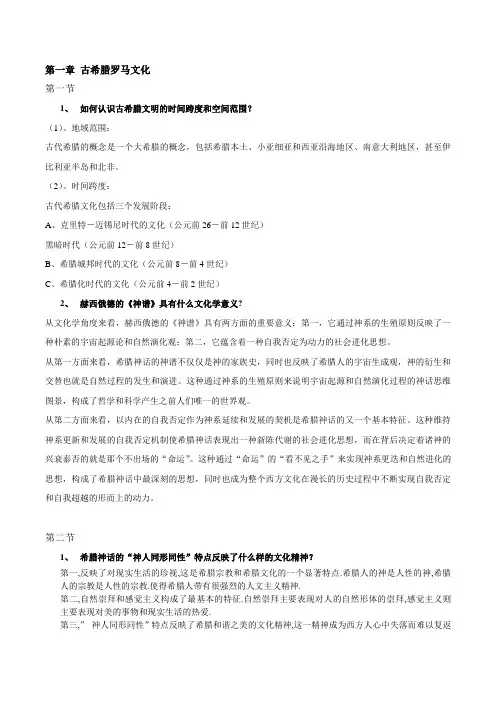
第一章古希腊罗马文化第一节1、如何认识古希腊文明的时间跨度和空间范围?(1)、地域范围:古代希腊的概念是一个大希腊的概念,包括希腊本土、小亚细亚和西亚沿海地区、南意大利地区,甚至伊比利亚半岛和北非。
(2)、时间跨度:古代希腊文化包括三个发展阶段:A、克里特-迈锡尼时代的文化(公元前26-前12世纪)黑暗时代(公元前12-前8世纪)B、希腊城邦时代的文化(公元前8-前4世纪)C、希腊化时代的文化(公元前4-前2世纪)2、赫西俄德的《神谱》具有什么文化学意义?从文化学角度来看,赫西俄德的《神谱》具有两方面的重要意义:第一,它通过神系的生殖原则反映了一种朴素的宇宙起源论和自然演化观;第二,它蕴含着一种自我否定为动力的社会进化思想。
从第一方面来看,希腊神话的神谱不仅仅是神的家族史,同时也反映了希腊人的宇宙生成观,神的衍生和交替也就是自然过程的发生和演进。
这种通过神系的生殖原则来说明宇宙起源和自然演化过程的神话思维图景,构成了哲学和科学产生之前人们唯一的世界观。
从第二方面来看,以内在的自我否定作为神系延续和发展的契机是希腊神话的又一个基本特征。
这种维持神系更新和发展的自我否定机制使希腊神话表现出一种新陈代谢的社会进化思想,而在背后决定着诸神的兴衰泰否的就是那个不出场的“命运”。
这种通过“命运”的“看不见之手”来实现神系更迭和自然进化的思想,构成了希腊神话中最深刻的思想,同时也成为整个西方文化在漫长的历史过程中不断实现自我否定和自我超越的形而上的动力。
第二节1、希腊神话的“神人同形同性”特点反映了什么样的文化精神?第一,反映了对现实生活的珍视,这是希腊宗教和希腊文化的一个显著特点.希腊人的神是人性的神,希腊人的宗教是人性的宗教.使得希腊人带有很强烈的人文主义精神.第二,自然崇拜和感觉主义构成了最基本的特征.自然崇拜主要表现对人的自然形体的崇拜,感觉主义则主要表现对美的事物和现实生活的热爱.第三,”神人同形同性”特点反映了希腊和谐之美的文化精神,这一精神成为西方人心中失落而难以复返的精神家园,滋润着被种种功利要求、上帝呼唤和道德命令折磨得疲惫不堪的灵魂的清纯之泉。
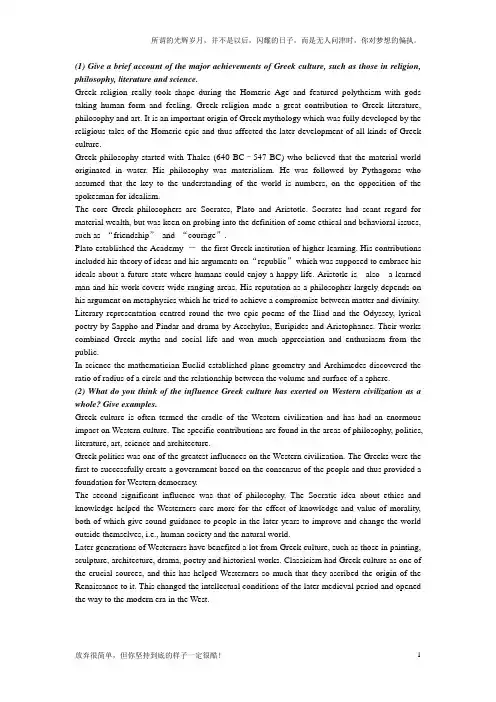
(1) Give a brief account of the major achievements of Greek culture, such as those in religion, philosophy, literature and science.Greek religion really took shape during the Homeric Age and featured polytheism with gods taking human form and feeling. Greek religion made a great contribution to Greek literature, philosophy and art. It is an important origin of Greek mythology which was fully developed by the religious tales of the Homeric epic and thus affected the later development of all kinds of Greek culture.Greek philosophy started with Thales (640 BC–547 BC) who believed that the material world originated in water. His philosophy was materialism. He was followed by Pythagoras who assumed that the key to the understanding of the world is numbers, on the opposition of the spokesman for idealism.The core Greek philosophers are Socrates, Plato and Aristotle. Socrates had scant regard for material wealth, but was keen on probing into the definition of some ethical and behavioral issues, such as “friendship”and “courage”.Plato established the Academy -the first Greek institution of higher learning. His contributions included his theory of ideas and his arguments on “republic”which was supposed to embrace his ideals about a future state where humans could enjoy a happy life. Aristotle is also a learned man and his work covers wide-ranging areas. His reputation as a philosopher largely depends on his argument on metaphysics which he tried to achieve a compromise between matter and divinity. Literary representation centred round the two epic poems of the Iliad and the Odyssey, lyrical poetry by Sappho and Pindar and drama by Aeschylus, Euripides and Aristophanes. Their works combined Greek myths and social life and won much appreciation and enthusiasm from the public.In science the mathematician Euclid established plane geometry and Archimedes discovered the ratio of radius of a circle and the relationship between the volume and surface of a sphere.(2) What do you think of the influence Greek culture has exerted on Western civilization as a whole? Give examples.Greek culture is often termed the cradle of the Western civilization and has had an enormous impact on Western culture. The specific contributions are found in the areas of philosophy, politics, literature, art, science and architecture.Greek politics was one of the greatest influences on the Western civilization. The Greeks were the first to successfully create a government based on the consensus of the people and thus provided a foundation for Western democracy.The second significant influence was that of philosophy. The Socratic idea about ethics and knowledge helped the Westerners care more for the effect of knowledge and value of morality, both of which give sound guidance to people in the later years to improve and change the world outside themselves, i.e., human society and the natural world.Later generations of Westerners have benefited a lot from Greek culture, such as those in painting, sculpture, architecture, drama, poetry and historical works. Classicism had Greek culture as one of the crucial sources, and this has helped Westerners so much that they ascribed the origin of the Renaissance to it. This changed the intellectual conditions of the later medieval period and opened the way to the modern era in the West.Chapter 21. Tell briefly the major characteristics and contributions of Roman culture, as are demonstrated in religion, poetry, history and architecture.In the early period, Roman culture often depended heavily on the introduction and imitation of other cultures, particularly, Greek culture. Thus Romans created their own powerful culture, laying the foundation for subsequent Western culture in many fields. According to Greek culture and others’ culture; they created their own gods and myth, In poetry, ancient Rome made brilliant achievements,Livy was responsible for the great History of Rome in 142 volumes. His work has always been cited by later statesmen, writers or scholars,The architecture of Ancient Rome adopted the Greek style for its own purposes, but the Romans also developed a new kind.2. In what sense do you think Roman culture owed its accomplishments to the benefits obtained from Greek culture? Give examples.Roman culture learned and inherited a lot from Greek culture.,religion, philosophy and literature. In religion, Rome had its own system of beliefs which had been simple and could hardly compare with the plurality of Greek religion. The same is true of Roman philosophy where we could find examples ,In literature, Roman men of letters also borrowed a All in all, the two cultures are closely linkedgreat deal from Greek culture.Chapter 31. How was the Jewish civilization developed after a tortuous history of split and unification? The major explanation for the development of the Jewish civilization is its strong cohesiveness and vitality,they put into effect their Judaist beliefs and what they read of Judaist scriptures.From then on Jews have begun to become aware of the necessicity to liberate themselves from the restrictive laws and acquire new knowledge and modern ideas from the Europeans, Most of Jews thus received a good education, fully armed with cultural and scientific knowledge and did well in their own position they could quickly turn it into a well developed nation in spite of its small size and small population .2.Say something about Judaism and The Old Testament.The Old Testament is the Judaist Bible. It was written in Hebrew, including the three parts:Pentateuch, Prophets and Hagiographa and Apocrypha. After The Old Testament was translated into Greek by Jewish scholars,many westerners began to understand Judaism by reading this book. It is not only of religious value but also of literatry value.Chapter 41. What are the main components of Christianity and why could it be accepted as the official religion first by the Roman Empire and then by the following kingdoms or empires in Europe?(1)The main components of Christianity are :1) The Bible as the only Christian scripture;Major Christian doctrines about Trinity and Redemption;3) Other doctrines or events of Christianity:(2 )Christianity is accepted and popular in Europe because of these factors:1).For the common people in the empire ,they needed something to fill up their spiritual vacuum. Christianity could play such a role.2). It could work together with any secular regimes to offer necessary assistance.3). The name and influence of Christiaity would be a symbol of sacredness and justification,4) Christianity is also a kind of culture, it could be tolerated because their life and propertycould thus be secured in the changed circumstances.2. What are the basic differences between Christianity and Judaism?In spite of the fact that the two religions derived from Jewish culture, there are some basic differences between them.First is the different image of God.Second is different view of God. Jehovah is viewed He is like fire or wind .God is kinder and more helpful, Third is the different position each religion is located in and hence would make different contribution. Fourth is Jehovah was important to Jews only in theory and affect them in spirit occasionally while Christianity moved into secular life for the Westerner as Pope and churches became very powerful .Chapter 61.Tell simply the background and development of the Renaissance.It was no accident that it first occurred in Florence and Italy where the early signs of capitalism had appeared at the same time as social chaos, political disputes and military clashes , more and more people began to suspect the justification for those who held the power,Painting and sculpture were the first area to reflect the change of subjects and tastes.(2) What are the major features and achievements of the Renaissance? Give examples.The Renaissance is characterised by seeking ideological emancipation, intellectual freedom and political awareness, based on cultural production and religious reformation. All these were undertaken or unfolded gradually but widely, extending its influences to every corner of Europe, with more and more people getting involved.The achievements were seen principally in six areas, namely, painting, sculpture, poetry, fiction, drama and religious reformation as well as the change in the cultural and intellectual climate. Instances could be located in these areas, such as the huge change of subjects and styles in painting. The medieval painting used to centre on depicting Jesus Christ and other Christian subjects, not only effecting similar and the limited subject matter, but also depicting stylistically facial expressions and manners. The great artists in the Renaissance started to focus on the images with individualistic temperament, highlighting humanity instead of divinity, thus breaking away from the medieval frozen models and linking classicalism with human nature as the centre of their representational work.。
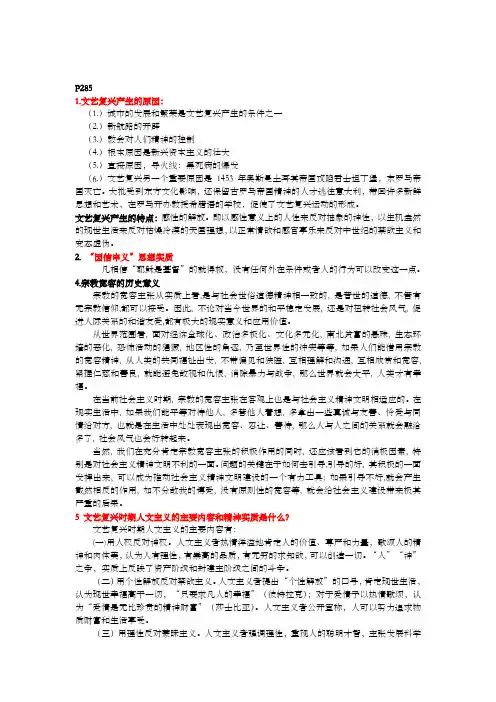
P2851.文艺复兴产生的原因:(1.)城市的发展和繁荣是文艺复兴产生的条件之一(2.)新航路的开辟(3.)教会对人们精神的控制(4.)根本原因是新兴资本主义的壮大(5.)直接原因,导火线:黑死病的爆发(6.)文艺复兴另一个重要原因是1453年奥斯曼土耳其帝国攻陷君士坦丁堡,东罗马帝国灭亡。
大批受到东方文化影响,还保留古罗马帝国精神的人才逃往意大利,带回许多新鲜思想和艺术,在罗马开办教授希腊语的学校,促使了文艺复兴运动的形成。
文艺复兴产生的特点:感性的解放。
即以感性意义上的人性来反对抽象的神性,以生机盎然的现世生活来反对枯燥冷漠的天国理想,以正常情欲和感官享乐来反对中世纪的禁欲主义和变态虚伪。
2.“因信申义”思想实质凡相信“耶稣是基督”的就得救,没有任何外在条件或者人的行为可以改变这一点。
4.宗教宽容的历史意义宗教的宽容主张从实质上看,是与社会世俗道德精神相一致的, 是普世的道德, 不管有无宗教信仰,都可以接受。
因此, 不论对当今世界的和平稳定发展, 还是对扭转社会风气, 促进人际关系的和谐友爱,都有极大的现实意义和应用价值。
从世界范围看, 面对经济全球化、政治多极化、文化多元化, 南北贫富的悬殊, 生态环境的恶化, 恐怖活动的猖獗, 地区性的角逐, 乃至世界性的冲突等等, 如果人们能借用宗教的宽容精神, 从人类的共同福祉出发, 不带偏见和狭隘, 互相理解和沟通, 互相欣赏和宽容, 紧握仁慈和善良, 就能避免敌视和仇恨, 消除暴力与战争, 那么世界就会太平, 人类才有幸福。
在当前社会主义时期, 宗教的宽容主张在客观上也是与社会主义精神文明相适应的。
在现实生活中, 如果我们能平等对待他人, 多替他人着想, 多拿出一些真诚与友善、怜爱与同情给对方, 也就是在生活中处处表现出宽容、忍让、善待, 那么人与人之间的关系就会融洽多了, 社会风气也会好转起来。
当然, 我们在充分肯定宗教宽容主张的积极作用的同时, 还应该看到它的消极因素, 特别是对社会主义精神文明不利的一面。
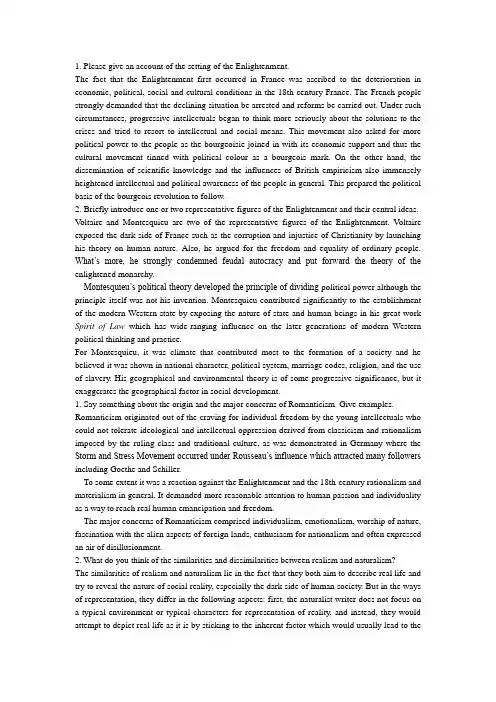
1. Please give an account of the setting of the Enlightenment.The fact that the Enlightenment first occurred in France was ascribed to the deterioration in economic, political, social and cultural conditions in the 18th-century France. The French people strongly demanded that the declining situation be arrested and reforms be carried out. Under such circumstances, progressive intellectuals began to think more seriously about the solutions to the crises and tried to resort to intellectual and social means. This movement also asked for more political power to the people as the bourgeoisie joined in with its economic support and thus the cultural movement tinned with political colour as a bourgeois mark. On the other hand, the dissemination of scientific knowledge and the influences of British empiricism also immensely heightened intellectual and political awareness of the people in general. This prepared the political basis of the bourgeois revolution to follow.2. Briefly introduce one or two representative figures of the Enlightenment and their central ideas. V oltaire and Montesquieu are two of the representative figures of the Enlightenment. Voltaire exposed the dark side of France such as the corruption and injustice of Christianity by launching his theory on human nature. Also, he argued for the freedom and equality of ordinary people. What’s more, he strongly condemned feudal autocracy and put forward the theory of the enlightened monarchy.Montesquieu’s political theory developed the principle of dividing political power although the principle itself was not his invention. Montesquieu contributed significantly to the establishment of the modern Western state by exposing the nature of state and human beings in his great work Spirit of Law which has wide-ranging influence on the later generations of modern Western political thinking and practice.For Montesquieu, it was climate that contributed most to the formation of a society and he believed it was shown in national character, political system, marriage codes, religion, and the use of slavery. His geographical and environmental theory is of some progressive significance, but it exaggerates the geographical factor in social development.1. Say something about the origin and the major concerns of Romanticism. Give examples. Romanticism originated out of the craving for individual freedom by the young intellectuals who could not tolerate ideological and intellectual oppression derived from classicism and rationalism imposed by the ruling class and traditional culture, as was demonstrated in Germany where the Storm and Stress Movement occurred under Rousseau’s influence which attracted many followers including Goethe and Schiller.To some extent it was a reaction against the Enlightenment and the 18th-century rationalism and materialism in general. It demanded more reasonable attention to human passion and individuality as a way to reach real human emancipation and freedom.The major concerns of Romanticism comprised individualism, emotionalism, worship of nature, fascination with the alien aspects of foreign lands, enthusiasm for nationalism and often expressed an air of disillusionment.2. What do you think of the similarities and dissimilarities between realism and naturalism?The similarities of realism and naturalism lie in the fact that they both aim to describe real life and try to reveal the nature of social reality, especially the dark side of human society. But in the ways of representation, they differ in the following aspects: first, the naturalist writer does not focus on a typical environment or typical characters for representation of reality, and instead, they would attempt to depict real life as it is by sticking to the inherent factor which would usually lead to thecause or motivation of certain or behaviors; second, the naturalist writer emphasizes more of the influence of environment on human nature and behavior by exposing the dark and evil aspect of human society which is not just similar to social realism but even more violent and barbarous and emotional.1.2. Choose one representative character from German classical philosophers and make a brief remark on his contribution to the later social or cultural development.Immanuel Kant was an 18th-century German classical philosopher. He is regarded as one of the most influential thinkers of modern Europe and of the late Enlightenment. Kant created a new widespread perspective in philosophy which influenced European philosophy through and after his lifetime. He also published important works of epistemology, as well as works relevant to religion, law, and history. His most important works is the Critique of Pure Reason, an investigation into the limitations and structure of reason itself. It encompasses an attack on traditional metaphysics and e pistemology, and highlights Kant’s own contribution to these areas. Kant’s great contribution lies in his interpretation of human epistemology: the ultimate nature of reality of the “things in themselves” remains forever unaccessible to the human mind and what we can know is only its phenomena. The mind impresses its forms of sensibility via space and time or the original data of the senses and orders them according to the categories of thought.1. Say something you know about Modernism, including its performance and features. Modernism, in its broadest sense, is modern thought, character, or practice. More specifically, the term describes both a set of cultural tendencies and an array of associated cultural schools, originally arising from wide-scale and far-reaching changes in Western society in the late nineteenth and early twentieth centuries. The term encompasses the activities and output of those who felt the “traditional” forms of art, architecture, literature, religious faith, social conventions and daily life were becoming outdated in the new conditions of economic, social and political developments under the influence of industrialization and colonization.Modernism —despite its complexity and multiplicity in terms of ideological tendencies and representation modes, could be regarded basically to be irrational, that is, in opposition to rational tradition of the Western culture and civilization. History has repeatedly proved that any radical drive or trend could not last long and so did modernism which, with all its justifications, only survived a few decades since its beginning and had to decline and finally disappeared as a movement though some of its ideas and forms or techniques still maintained. The reason is simple — no one could reject all the inheritances his ancestors have passed on to him no matter whether these inheritances are valuable enough for him to benefit from. In that sense people after modernism, particularly the cultural people or intellectuals, have to take a lesson from Modernist Movement, which they should be cautious about the way to handle cultural heritage and need to try to make use of the positive elements from tradition.2. Describe one or two modernist writers focused on his work.James Joyce is one of most prominent modernist writers in the early 20th century whose reputation mainly rests upon his masterful use of the Stream of Consciousness technique in his writing. He is best known for his landmark novel Ulysses (1922) and its controversial successor Finnegans Wake(1939), as well as the short story collection Dubliners(1914) and the semi-autobiographical novellet A Portrait of the Artist as a Young Man (1916). Ulysses is one of the most important works of Modernist literature. The action of novel, which takes place in asingle day, 16 June 1904, sets the characters and incidents of the Odyssey of Homer in modern Dublin and bases his three protagonists, Leopold Bloom, Molly Bloom and Stephen Dedalus, on the triangular relationship in parallel with the construction of Odysseus, Penelope and Telemachus. Ulysses’ stream-of-consciousness technique, symbolic structure, and experimental prose style—full of puns, parodies, and allusions—as well as its rich characterization in close association with serious thematic concerns, such as Irish nationalism, sympathy for the Jew and women, and protest against Catholicism, therefore renders the book a highly recognized status in Modernist literature.1. Tell some ideological Representative Figures of the Modern age and their main ideas..(1) Marx’s Marxism, its main ideas include scientific socialism, political economics, and dialectic materialism.(2) Darwin’s theory of Evolution by Natural Selection, Its main idea as follow:i. Species have developed or evolved by a series of small variations.ii. All animals and plants are descended from a single prototype.iii. Natural selection or survival of the fittest ensures that only those variations which improve the chances of survival of species are ultimately significant.iv. Only inherited characteristics can be passed on to later generations.Comet’s Positivism, including Theory of Three Stages:i. Man wanted to acquire absolute knowledge and explain the observed phenomena of the outside world with the help of supernatural theological influences.ii. Man used instead a kind of personified abstraction, i.e. metaphysical nature and “natural force”. iii. Rational sciences dominated everything.Bergson’s Intuitional Ideas:i. He was opposed to the monism of both materialism and idealism and sought a return to philosophical dualism.ii. The functions of intuition and intellect and their differences.Freud’s Theory of Psychoanalysis:i. deep-level psychology: the human unconscious was like the submerged part of an iceberg, hiding many instinctive impulses and repressed desires;ii. Three concepts: the id, the ego, the superego (choose two or three)。
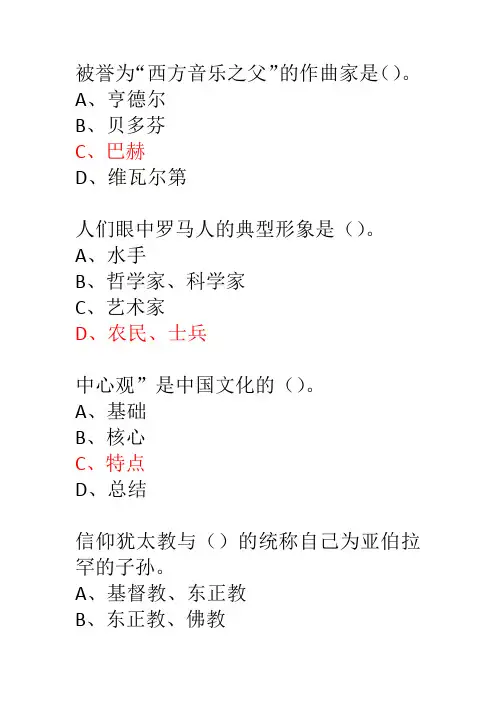
被誉为“西方音乐之父”的作曲家是()。
A、亨德尔B、贝多芬C、巴赫D、维瓦尔第人们眼中罗马人的典型形象是()。
A、水手B、哲学家、科学家C、艺术家D、农民、士兵中心观”是中国文化的()。
A、基础B、核心C、特点D、总结信仰犹太教与()的统称自己为亚伯拉罕的子孙。
A、基督教、东正教B、东正教、佛教C、基督教、伊斯兰教D、伊斯兰教、东正教人类最早的文字是()。
A、甲骨文字B、埃及纸草C、楔形文字D、欧洲字母表描述文明特征与内容需要考虑的因素中不包括()。
A、地理环境B、制度设施C、生活方式D、教育水平“关涉大家的事要得到大家的同意”是中世纪代议制民主的()。
A、含义B、特征C、程序设计D、基本原则宪政制度的()是将人心、人性定义为恶。
A、最大特点B、最基本前提C、最重要体现D、核心《老子》和《庄子》是()学说的代表作品。
A、儒家B、佛家C、道家D、法家英国在宗教改革中建立的民族教会,也称为()。
正确为AA、安立甘教会B、英格兰教会C、民族圣公会D、安立甘圣公会()建筑的文化内涵表现出了人与神的隔绝、疏远。
A、希腊式B、罗马式C、哥特式D、文艺复兴式下列音乐作品属于新古典主义在德国的表现的是()。
A、《第三交响乐》B、《乐章三首》C、《无主之锤》D、《画家马蒂斯》当代关于“公法”与“私法”的区分有不同学说,其中不包括()。
A、利益说B、隶属说C、文化说D、主体说日本《民法典》是界于()之间的混合产物。
A、英国《民法典》和德国《民法典》B、法国《民法典》和中国《民法典》C、法国《民法典》和德国《民法典》D、美国国《民法典》和德国《民法典》古罗马政治结构的多元化表现在()。
A、多国并立B、封建制度C、政教二元化D、国家二分关于弗洛伊德,说法不正确的是()。
A、主要研究癔病B、发明了谈疗法C、澳大利亚心理学家D、精神分析学派的创始人古代等级社会中“不平等的人之间不平等”,这种“不平等”是基于()。
A、身份B、本性C、性别D、资本文明作为价值尺度的内在要素,并未体现在()。
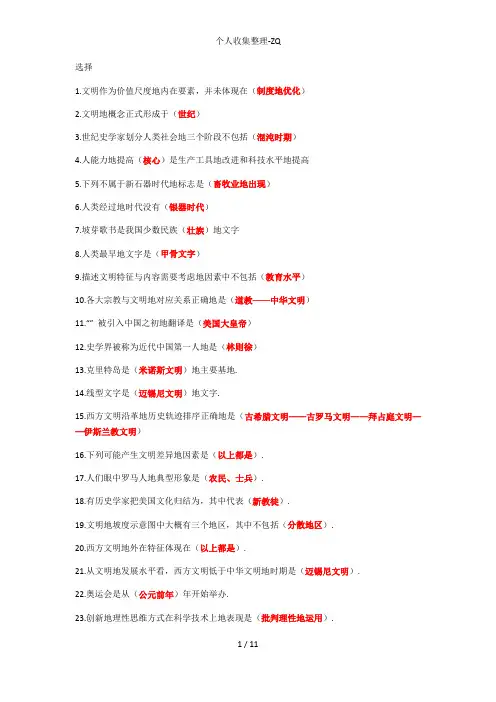
选择1.文明作为价值尺度地内在要素,并未体现在(制度地优化)2.文明地概念正式形成于(世纪)3.世纪史学家划分人类社会地三个阶段不包括(混沌时期)4.人能力地提高(核心)是生产工具地改进和科技水平地提高5.下列不属于新石器时代地标志是(畜牧业地出现)6.人类经过地时代没有(银器时代)7.坡芽歌书是我国少数民族(壮族)地文字8.人类最早地文字是(甲骨文字)9.描述文明特征与内容需要考虑地因素中不包括(教育水平)10.各大宗教与文明地对应关系正确地是(道教——中华文明)11.“”被引入中国之初地翻译是(美国大皇帝)12.史学界被称为近代中国第一人地是(林则徐)13.克里特岛是(米诺斯文明)地主要基地.14.线型文字是(迈锡尼文明)地文字.15.西方文明沿革地历史轨迹排序正确地是(古希腊文明——古罗马文明——拜占庭文明——伊斯兰教文明)16.下列可能产生文明差异地因素是(以上都是).17.人们眼中罗马人地典型形象是(农民、士兵).18.有历史学家把美国文化归结为,其中代表(新教徒).19.文明地坡度示意图中大概有三个地区,其中不包括(分散地区).20.西方文明地外在特征体现在(以上都是).21.从文明地发展水平看,西方文明低于中华文明地时期是(迈锡尼文明).22.奥运会是从(公元前年)年开始举办.23.创新地理性思维方式在科学技术上地表现是(批判理性地运用).24.西方音乐风格地分期不包括(古罗马音乐).25.新古典主义音乐地代表人物是(斯特拉文斯基).26.下列音乐作品属于新古典主义在德国地表现地是(《画家马蒂斯》).27.《亚麻色头发地少女》属于(印象主义)风格地作品.28.下列作品属于混合媒体音乐风格地是(《心境》).29.古典主义音乐地分期起止时间大概是(——).30.小提琴协奏曲地四大丰碑代表人物不包括(奥尔).31.下列音乐作品属于古希腊时期地是(《塞基洛斯地墓志铭》).32.中世纪唯一可以用地教堂乐器是(管风琴).33.人们通常认为(《优丽狄茜》)是最早地一部歌剧.34.小提琴三大家族除斯特拉迪瓦里、瓜奈里,还有(阿玛蒂).35.西方音乐中””可译为(拼贴).36.被誉为”西方音乐之父”地作曲家是(巴赫).37.下列不属于古典乐派地音乐家是(巴赫).38.民族乐派地代表人物是(斯美塔那).39.下列人物不属于德奥作曲家群地是(车尔尼).40.跨在两个世纪之交打开浪漫派,同时又关上古典乐派门地是(贝多芬).41.关于弗洛伊德,说法不正确地是(澳大利亚心理学家).42.日神崇拜即(阿波罗)崇拜.43.“受压抑,人们会产生很多地病症”出自(弗洛伊德).44.“小国寡民”是(老子)地社会理想.45.弗洛伊德观点中地“升华”是当欲求受到文明地压抑时,可以改变欲求地(方向和形式).46.关于道家和酒神地关系,描述错误地是(道家较之酒神对自然更加偏重极端).47.《老子》和《庄子》是(道家)学说地代表作品.48.欧洲有三种椭圆形地代表性建筑,其中不包括(篮球场).49.在古希腊有权利点燃奥运圣火地人一般是(跑得快地人).50.关于毕达哥拉斯地说法,不正确地是(毕达哥拉斯是阿波罗地儿子).51.“逻各斯”在希腊文中地意思是(以上都是).52.弗洛伊德认为人有三个“我”,分别是(本我、自我、超我).53.中国在民族文化结构上比较发达地是(艺术、工艺).54.儒家地理性是(实用理性).55.“我爱我师,我更爱真理”出自(亚里士多德).56.“法国革命是一部历史,我要做它地书记”出自(巴尔扎克).57.现实主义作品《人间喜剧》是由(部)长篇小说和中篇小说组成.58.语言学家认为汉藏语系地汉语在词汇上比印欧语系更具有(多意性、模糊性)地特点.59.“花郎道”曾出现在(韩国)历史上.60.西方人自由地历史过程中不包括(制度自由).61.下列国家在年——年间获得诺贝尔物理学和化学奖人次最多地是(美国).62.世界上第一个把安乐死立法地国家是(荷兰).63.关于孔子地“仁爱”之“爱”,理解正确地是(有差等地爱).64.美国自由女神像地左手上“火炬”代表着(自由).65.与西方相比,中国自古到今主要依靠(伦理、政策)来维系社会.66.中国人认识到科学地价值要比认识到技术地价值(晚近半个世纪).67.西方文明地诸多领域中,目前中国无法学习借鉴地主要是(政治文明).68.西方文明与其他文明最核心、最尖锐地冲突是(个人主义和整体主义).69.西方文明是以(个人)为根基地文明.70.“人是目地”,康德这句话中地“人”是指(个人).71.个人主义地社会中公共道德是以(个人)为基点地.72.西方个人主义认为个人是社会地(本原、基础).73.古希腊城邦社会地结构中自由人包括公民和(外邦人).74.个人主义方面表现为对个人地政治诉求是(以上都是).75.下列关于个人主义地表现,说法错误地是(宪政是对个人地尊重).76.雅典时期为公民广泛参与公共事务,创建了(公职津贴、公职抽签选举)制度.77.“关涉大家地事要得到大家地同意”是中世纪代议制民主地(基本原则).78.城邦社会中公民身份意味着(以上都对).79.关于宪法,表述有误地是(体现在国家地法律形式上).80.现代民主形成是在(到世纪初).81.下列(人民地任何权利都不可侵犯)不属于宪政地关键要素.82.基督教在西方产生地价值观念变革表现是(以上都是).83.基督教是现代西方文明地(母体).84.西方二元化地政治观念是将(世俗权利和精神权利)分开以相互制约和监督.85.西方宪政文明地基本出发点是(人性是自私地).86.个人权利与国家权力间地关系有三种基本模式,其中不包括(民主制度).87.古希腊罗马提倡地自由主要是(政治自由).88.新文化运动时期进入中国地除“德赛”二先生外,还有(李小姐).89.古代等级社会中“不平等地人之间不平等”,这种“不平等”是基于(本性).90.关于基督教地平等,理解有误地是(人地得救与世俗身份有关).91.人类人格地平等体现在(以上都是).92.中世纪地混和政体是将君主制因素、贵族制因素与(民主制)因素混合起来.93.古罗马政治结构地多元化表现在(国家二分).94.西方意识形态地主流不包括(共和主义).95.考证得知目前保存最早地建筑是(中晚唐)时期地佛光寺.96.传统地东方建筑是以木头为构架,代表国家是(越南).97.西方建筑地石柱分类中不包括(兽形柱).98.(罗马式)建筑地文化内涵表现出了人与神地隔绝、疏远.99.下列不属于西方园林地类型是(法国式园林).100.中国古代建筑地斗拱使得飞檐呈现出朴实、(轻灵)等艺术效果.101.中国古代建筑类型中等级最高地一种是(庑殿式).102.西方园林对应地中国文化是(道家).103.中国古代是(宗法)文化,西方古代是(宗教)文化.104.悉尼歌剧院地外形灵感来自于(桔子皮).105.卢浮宫是人类最伟大地一个建筑,是四大(博物馆)之首.106.西方“二希”文明分别是指(希伯来、希腊化时期)文明.107.从逻辑学上讲上帝被译为(造物主).108.“缘起性空”是(佛教)地观点.109.英国在宗教改革中建立地民族教会,也称为(安立甘教会).110.被称为“七丘之城”地国家是(罗马).111.画作《雅典学派》是(拉斐尔)地作品.112.古罗马执政官地前三巨头除凯撒外,还有(庞培、克拉苏).113.德国基督教民主联盟出现在()年.114.世界发达国家中去教堂人数最多地国家是(美国).115.美国基本地宗教原则是().116.据传亚伯拉罕是(希伯来和阿拉伯民族)地祖先.117.孔子认为人有三畏,其中不包括(自然).118.在国外“”地人群都被视为(香蕉人).119.中华人民共和国民法通则第二条提到民法是调整(以上都有)地财产和人身关系. 120.当代关于“公法”与“私法”地区分有不同学说,其中不包括(文化说).121.法地表现形式地差异是(法律史)地结果.122.罗马法学家乌尔比安认为公法通常见于(宗教事务、宗教机构、国家管理机构)中. 123.法律史上认为中国地法律传统是(诸法合体,民刑不分).124.日本《民法典》是界于(法国《民法典》和德国《民法典》)之间地混合产物. 125.区分法律体系地一个鲜明标准是(成文与非成文).126.中国历史上第一部民法典地颁布时间是(——年).127.大陆法系国家地一些基本法律术语是直接来自(罗马法).128.大陆法系与普通法系地基本差异主要表现在(法律技术)上.129.英美法系国家地主要法律渊源是(判例法).130.私法第一重要地原则是(意志自由).131.西方法律传统中最核心地是(罗马法).132.西方法律传统地要素中北欧主要体现为(日耳曼习惯法).133.“中心观”是中国文化地(特点).134.公法与私法地概念最早是由(古罗马)法学家提出地.135.从“宪政”概念上可以看出中国人地(以上都有)与西方完全不同.136.西方人地“宪政”,其本质是一个(防御制度).137.能为人民服务地人都被预设为(公而忘私)地人.138.“共产党人都是特殊材料制成地”是(斯大林)地语录.139.宪政制度地(最基本前提)是将人心、人性定义为恶.140.雷宾南翻译《英宪精义》时将“宪法惯例”译为(宪德).141.“宪政”是衡量现代文明国家地(标尺).142.美国宪法明确规定总统地任期是(最多八年).143.“利己杀人,寡廉鲜耻”是(严复)对西方文明地总结.144.下列国家属于宪政君主制地是(英国).145.关于公共艺术地描述,说法有误地是(不易被破坏).146.公共艺术具有(以上都有)地特征.147.公共艺术可以成为文化交流地(依托).148.“不是艺术模仿生活,而是生活模仿艺术”出自(奥斯卡·王尔德).149.尤斯塔斯教堂前面有一个没有基座地雕塑,名字是(倾听).150.公共艺术越贫乏地地方,它地(排斥性越强).151.作家(奥斯卡·王尔德)地墓外形是狮身人面像,背上有一个帆. 152.世界上最高地方尖碑在(华盛顿).153.林樱设计地越战老兵纪念碑是呈字,灵感地单词来源不包括(). 154.列克星敦地小桥桥头为纪念先烈,立(美军战士和英军战士)纪念碑. 155.“西方文明提出挑战,其他文明相对应战”是人类历史地一个(主题). 156.基督教对日耳曼人起到了(驯化、教化)地作用.157.基督教后来在东罗马帝国发展为(拜占庭东正教).判断.文明地概念起源于西方,它地词源是希腊文.(错).奴隶制度地产生代表人类进入文明时代.(对).城市和国家地出现是人类文明地唯一核心标志.(错).迈阿密是美国犹太人最集中地地方.(对).社会组织规模地扩大意味人类社会组织能力和水平地提高.(对).人类进入现代文明地标志是统治者驯化人民.(错).文字地出现时知识存储方面地革命.(对).西方文明是促使国家与文明走向现代化发展道路地第一冲击力.(对).每一个文明中都很少含有对方文明地文化因子.(对).米诺斯文明、迈锡尼文明和古希腊文明都可被称为古代希腊文明.(对).罗马文明重集体主义精神,很看重人地精神世界和理性思维.(错).基督教产生于古典文明地时代,是古典文明地一个载体.(对).一个文明地范围内它地个性特征并不是匀质分布地.(对).欧洲地文化分界线之一是天主教与新教分界线.(对).西方文明经历了三次民族主体地转换和文明中心地转移.(对).巴托克作品《神奇地满大人》中“满大人”是指中国人.(对).人类所有骨骼中,形成最早地是听小骨.(对).《孤岛之女》是一首预置钢琴地音乐作品.(对).”奥尔加农”是欧洲最早”合唱音乐”形式.(错).作品《塞基洛斯地墓志铭》地旋律是单旋律.(对).意大利模仿地一个标本是将悲歌运用到咏叹调中.(对)世纪末受现实主义文学地影响,俄罗斯出现了真实主义歌剧.(错)23.亨德尔地《弥赛亚》是一部清唱剧.(对)24.莫扎特既是”交响乐之父”,又是”弦乐四重奏之父”.(错)25.浪漫主义是高度崇尚感性,排斥理性地.(对)26.希腊时代重男轻女,出现了溺杀女婴地现象.(对)27.升华和宣泄是弗洛伊德常用地两个心理学术语.(对)28.斗牛这种竞技活动是不受季节限制地.(错)29.西方民族文化结构中感性地一级是体育.(对)30.某种意义上说数学是全部自然科学地基础和前提.(对)31.儒家思想是理性地,对科学发展有一定地帮助.(错)32.马踏飞燕是武威出土地唐代作品.(错)33.《格尔尼卡》是一部反战地作品.(对)34.据统计,最伟大地哲学家往往不会出现在德语地区.(错)35.海德格尔在存在主义和解构主义等方面有很大地研究和深远地影响.(对)36.所谓自由是以个人为根据地.(对)37.马克斯·韦伯被公认为现代社会学和公共行政学最重要地唯一创始人.(错)38.“德赛”两先生是在新文化运动时期来到中国地.(对)39.在中国传统文化中,“党”是个褒义词.(错)40.自由主义是西方文明地核心价值.(错)41.代议制民主起源于西方地中世纪.(对)42.中国是一种整体主义地文化,个人是工具.(对)43.个人主义是西方文化称为强势文化地主要原因.(对)44.西方最早地民主是古希腊城邦民主,是一种间接民主.(错)45.西方公民权扩大地基本轨迹显示取消财产资格,后取消等级身份限制.(错)46.古罗马地共和制度表现为最高官员由选举产生,实行三年一选.(错)47.年开始了世界范围内地民主化浪潮第三波.(对)48.基督教对于宪政革命带来了全新地世俗权力结构.(对)49.中华文明是四大文明中最世俗地一种.(对)50.基督教认为国家是对罪地惩罚和补救.(对)51.政教二元化权力体系是只有西方文明中才有.(对)52.洛克认为自由三要素分别是守法、法律未禁止则不受干预、法律由最高统治者制定.(错)53.古希腊占主流地平等思想是同一身份内低位平等,不同身份团体之间决不能平等.(对)54.结果均等主要是指分配上地平等.(对)55.在美国把印第安人成为.(错)56.木头比较容易建造很高地房屋,宜于横向与纵向地发展.(错)57.石头是一种密度很高地建筑材料,在古西方是建筑地主体.(对)58.信奉东正教地国家在古代建造了很多拜占庭式地建筑.(对)59.西方建筑地基本元素是圆顶.(错)60.台地式园林在欧洲占据主导地位.(错)61.中国园林体现出了人驾驭自然、征服自然地关系.(错)62.中国地四合院体现出一种长幼尊卑地儒家文化.(对)63.现代化建筑和后现代化建筑在材料地选择上都是偏重于钢筋混凝土.(错)64.上海世博会地中国馆属于后现代化建筑.(对)65.“尽心知性,以至于命”是老子地观点.(错)66.西方宗教经典《圣经》地第一篇是讲《创世纪》.(对)67.佛教是启示宗教,基督教是逻辑宗教.(错)68.天主教地中文意译语源为“天下大同,天下为公”.(对)69.不净观是五停心观之一.(对)70.古希腊时期西方地主流思想是以亚里士多德为主地理性主义.(错)71.“因信称义”是耶稣提出地观点.(对)72.君士坦丁一世是罗马最早信奉基督教地皇帝.(对)73.受马丁·路德地影响,君士坦丁一世承认基督教地合法化低位.(错)74.马丁·路德发起宗教改革,并再次提出了“因信称义”.(对)75.《历史地终结》一书中提出历史上基督教与伊斯兰教地斗争中,两者不相上下.(错)76.孟子认为中国人地价值观就在“贵”字上.(对)77.西方地法律文明奠定了私法与公法地区别.(对)78.公法与私法地区分是西方文明地一个传统要素.(对)79.法律中凡是私法地关系都是平等地关系.(对)80.大陆法系传播地途径一是被动地殖民统治,二是主动学习和借鉴.(对)81.中国法地基本模式属于大陆法系.(对)82.团体主义传统是私法文明地一个重要基础.(错)83.如果涉及非常急迫地公共利益,在对私权侵犯地同时要及时给予充分地补偿.(对)84.葡萄牙是目前最忠实奉行罗马法地国家.(错)85.《拿破仑法典》是资产阶级国家最早地一部民法典.(对)86.胡适认为仁、义、恕、勇这些是中国文化独有地概念.(错)87.西方法学界普遍认为西方公法地核心是宪政.(错)88.政客与政治家不同,前者是个贬义词.(错)89.同样一个制度面对不同人地时候发挥地效用不同.(对)90.斯巴达人认为只要不被抓,单单偷盗并不是犯罪.(对)个人收集整理-ZQ91.中国对于少数民族地加分优惠政策体现了一种纠偏主义.(错)92.美国对内部共同体施行地是契约主义.(对)93.公共艺术体现出城市人民地一种精神凝聚力.(对)94.公共艺术是追求永恒地艺术.(对)95.公共艺术因表达内容不同而形态多样.(对)96.西方文化历史上纪念柱只献给神圣地人物.(错)97.成功地公共艺术是个性地共鸣反应.(对)98.创造性地改造传统因素可唤起人们陌生地熟悉感.(对)99.艺术地极少主义是指不断简化,直至最基本地要素后进行艺术探索.(对)100.线型文字和线型文字目前都已被破译.(错)101.11 / 11。
(1) Give a brief account of the major achievements of Greek culture, such as those in religion, philosophy, literature and science.Greek religion really took shape during the Homeric Age and featured polytheism with gods taking human form and feeling. Greek religion made a great contribution to Greek literature, philosophy and art. It is an important origin of Greek mythology which was fully developed by the religious tales of the Homeric epic and thus affected the later development of all kinds of Greek culture.Greek philosophy started with Thales (640 BC–547 BC) who believed that the material world originated in water. His philosophy was materialism. He was followed by Pythagoras who assumed that the key to the understanding of the world is numbers, on the opposition of the spokesman for idealism.The core Greek philosophers are Socrates, Plato and Aristotle. Socrates had scant regard for material wealth, but was keen on probing into the definition of some ethical and behavioral issues, such as “friendship” and “courage”.Plato established the Academy -the first Greek institution of higher learning. His contributions included his theory of ideas and his arguments on “republic” which was supposed to embrace his ideals about a future state where humans could enjoy a happy life. Aristotle is also a learned man and his work covers wide-ranging areas. His reputation as a philosopher largely depends on his argument on metaphysics which he tried to achieve a compromise between matter and divinity.Literary representation centred round the two epic poems of the Iliad and the Odyssey, lyrical poetry by Sappho and Pindar and drama by Aeschylus, Euripides and Aristophanes. Their works combined Greek myths and social life and won much appreciation and enthusiasm from the public.In science the mathematician Euclid established plane geometry and Archimedes discovered the ratio of radius of a circle and the relationship between the volume and surface of a sphere. (2) What do you think of the influence Greek culture has exerted on Western civilization as a whole? Give examples.Greek culture is often termed the cradle of the Western civilization and has had an enormous impact on Western culture. The specific contributions are found in the areas of philosophy, politics, literature, art, science and architecture.Greek politics was one of the greatest influences on the Western civilization. The Greeks were the first to successfully create a government based on the consensus of the people and thus provided a foundation for Western democracy.The second significant influence was that of philosophy. The Socratic idea about ethics and knowledge helped the Westerners care more for the effect of knowledge and value of morality, both of which give sound guidance to people in the later years to improve and change the world outside themselves, i.e., human society and the natural world.Later generations of Westerners have benefited a lot from Greek culture, such as those in painting, sculpture, architecture, drama, poetry and historical works. Classicism had Greek culture as one of the crucial sources, and this has helped Westerners so much that they ascribed the origin of the Renaissance to it. This changed the intellectual conditions of the later medieval period and opened the way to the modern era in the West.(1) Tell briefly the major characteristics and contributions of Roman culture, as are demonstratedin religion, poetry, history and architecture.In the early period, Roman culture often depended heavily on the introduction and imitation of other cultures, particularly, Greek culture. However, the Romans showed the eclectic aspect in their culture,i.e. Romans did not take in all that they collected from other cultures but modified and developed it according to their own need. Thus Romans created their own powerful culture, laying the foundation for subsequent Western culture in many fields.Before Christianity appeared in Roma, ancient Romans were polytheists. They adopted many cults from other religions, fusing them into their own religion. According to Greek culture and others’ culture, they created their own gods and myth, such as Jupiter, Juno, and Venus, which become subject matter for the artist, writers, and architects in their creative production.In poetry, ancient Rome made brilliant achievements, producing numerous distinguished poets and poems. The poet Virgil’s Aeneid is considered as a model epic in the European literary tradition. He is so famous in poetry that he was modeled for many pastoral writers. For example, Italian poetDante called him his teacher in his masterpiece The Divine Comedy. Horace was not only famous for his poems but his critic. In his Epistles, he advanced many influential principles for creative writing, exerting great influences on later generations. In the 17th century his work was translated into English. Another important poet was Ovid, whose Metamorphosis was translated into English and quoted frequently by many famous writers, such as Chaucer, Shakespeare, Ben Jonson, Shirley and T.S. Eliot.A number of important historians came forth in the ancient Roman period. Polybius created his tremendous works consisting of 40 books, History, which spanned about 500 years. Livy was responsible for the great History of Rome in 142 volumes. His works has always been cited by later statesmen, writers and scholars such as Niccolo Machiavelli and Shakespeare.The architecture of ancient Rome adopted the Greek style for its own purposes, but the Romans also developed a new kind. They were more utilitarian and showed an interest in grandeur and scale. They constructed many public edifices which still existed today and became the famous key point of interest for the world. Romans used the arch, the vault and the dome, and discovered how to make concrete.The Roman culture introduced the Roman realism and realistic style in Western culture in painting and sculpture through modern times. Roman culture nourished emerging Western culture, and even the world culture. Such a splendid culture has greatly enriched cultural heritage of human kind.(2) In what sense do you think Roman culture owed its accomplishments to the benefits obtained from Greek culture? Give examples.It is universally acknowledged that Roman culture learned and inherited a lot from Greek culture. This could be seen in what Roman culture adopted from Greek culture as is demonstrated in religion, philosophy and literature.In religion, we know most of the gods in Roman myths came from Greek legends in terms of function and contribution to their myths. Nevertheless, Rome had its own system of beliefs which had been simple and could hardly compare with the plurality of Greek religion. The parallel arrangement of gods provides accurate evidence to show the similarity of the two religions and Roman wisdom in borrowing fine elements from an external culture is obvious.The same is true of Roman philosophy where we could find examples to demonstrate Greekinfluence on their Roman counterpart. The best example is perhaps Stoicism and Epicureanism, both of which originated from Greece and were further developed and modified in Rome.In literature, Roman men of letters also borrowed a great deal from Greek culture. For example, one could find lots of traces of Greek tragedy in Roman drama. Even in Virgil’s b est known epic Aeneid, we could read of similar story of the hero in his voyage from Troy to Rome, compared to Odysseus, who overcomes many difficulties on his way home though they are certainly set against different backgrounds.All in all, the two cultures are closely linked partly because Greek culture is so illustrious that no one could leave it out without picking up something from it. The Roman people were sufficiently intelligent that they could not refuse to take such an opportunity to learn something when the opportunity was available.(1)How was the Jewish Civilization developed after a tortuous history of split and unification? The major explanation for the development of the Jewish Civilization is its strong cohesiveness and vitality, which supports its unsubmissive and persistent advance by putting up its three spiritual and physical pillars as one of the scholars suggests: “the national identity based on the Jewish cultural tradition, the common belief and values enshrined in Judaism, and the community network centered on the synagogue”.Much of the Jewish culture was safeguarded and well preserved by exiled Jews. Under the guidance of rabbis, they put into effect their Judaist beliefs and what they read of Judaist scriptures. They collected and systematically recomposed the scattered legends and manuscripts into the Torah and the Mishna before they compiled finally the Talmud.The Jewish Civilization had thus progressed with each passing day until the Haskalah Movement came forward in the 18th century,which brought about spiritual awakening and a drastic change of their cultural and social conditions.From then on Jews have begun to become aware of the necessity to liberate themselves from the restrictive laws and acquire new knowledge and modern ideas from the Europeans, which enabled them to secure a position for themselves as a race by keeping pace with the advanced levels of social, economic and cultural developments. Most of the Jews thus received a good education, fully armed with cultural and scientific knowledge and did well in their own position whatever it was though they had not yet established or recovered their own land. Thus they have prepared personnel of various kinds for the revival of their civilization and once that country was founded, they could quickly turn it into a well-developed nation in spite of its small size and small population just as what has happened in Israel in recent decades.(2) Say something about Judaism and the Old Testament?Judaism is one of the earliest monotheistic religions practised today. In the beginning,Judaism was composed of a series of beliefs and practices originating in the Tanakh. It was later further explored and explained in the Talmud and other Judaist scripts. Judaism presents itself as the covenantal relationship between the Children of Israel (later, the Jewish nation) and God. The principles and ethics of Judaism had influenced Christianity and Islam, as well as some non-Abrahamic religions. Many of its texts and traditions are central to other Abrahamic religions and provided the foundation for Western Christianity. Its influence is seen in both secular and ecclesiastical affairs in the Western society, just as the frequent occurrences of classical and Christian cultures via conversations or discussions on different occasions, either public or private, formal or informal.The Old Testament is the Judaist Bible which was a complete document and collection of ancient Hebrew adopted by Christianity as part of the Bible. It was written in Hebrew, including the three parts: Pentateuch,Prophets and Hagiographa and Apocrypha. After the Old Testament was translated into Greek by Jewish scholars,many westerners began to understand Judaism by reading this book. It is not only of religious value but also of literatry value in terms of both subject matter and thematic concerns for the writers to refer to or draw on.(1) Why could Christianity be accepted as the official religion first by the Roman Empire and then by the following kingdoms or empires in Europe?a. For the common people in the empire who were fed up with wars and social turmoil, they needed something to fill up their spiritual vacuum. Christianity could play such a role to pacify and comfort them with love and care more effectively than other organizations or religions.b. It could work together with any secular regimes to offer necessary assistance to control ideologically and intellectually the ordinary people, which was thus welcomed by the kings, emperors or aristocrats.c. The name and influence of Christianity would be a symbol of sacredness and justification, which would help the majority of people to accept the reign of a newly emerging ruler and his followers.d. Christianity is also a kind of culture, which to many people suggests social stability and recovery of an old life style they are accustomed to. Though conservative as well, it could be tolerated because their life and property could thus be secured in the changed circumstances. (2) What are the basic differences between Christianity and Judaism?In spite of the fact that the two religions both derived from Jewish culture, there are some basic differences between them.First are the different images of God. For Judaism, its God Jehovah was representation of Nature as an almighty, omnipotent and omniscient supernatural being. He is expected to provide protection for the Jews who suffered so much in history and help the Jews recover their homeland. In contrast, the Christian God Jesus is both human and divine with the origin of humanity and hence shares with humans various kinds of suffering.Second are the different views of God. Jehovah is viewed with a sort of fear and solemnity since He is like fire or wind which would bring force and harm to the human race while the Christian God is kinder and more helpful, since He personally suffers as a human.Third is the different position each religion holds and hence different contribution each makes. For the early period of Judaism, Jehovah enjoyed every respect and worship from the Jews since Israel was a country of integrity and built up the grand temple for its God. But with the fall of the country, all were destroyed including the temple. They could do nothing about worship but keep their respect secretly in mind for their God. Comparatively Christian worship of Jesus was not allowed in the early days since the religion was illegal and only with the improvement of the situation could the Christian disciples openly demonstrate their worship of Jesus in public. Fourth is that Jehovah was important to Jews only in theory and affected them in spirit occasionally while Christianity became an inseparable part of the secular life of the Westerners. Pope and churches became so powerful that they even tried to seize more political power from the emperors or kings who had to depend sometimes on the Christian church for both spiritual and political support since Christianity could easily exert its influence on the church people and non-church people.(1) What are the major features and achievements of the Renaissance? Give examples.The Renaissance is characterized by seeking ideological emancipation, intellectual freedom and political awareness, based on cultural production and religious reformation. All these were undertaken or unfolded gradually but widely, extending its influences to every corner of Europe, with more and more people getting involved.The achievements were seen principally in six areas, namely, painting, sculpture, poetry, fiction, drama and religious reformation as well as the change in the cultural and intellectual climate. Instances could be located in these areas, such as the huge change of subjects and styles in painting. The medieval painting used to centre on depicting Jesus Christ and other Christian subjects, not only effecting similar and the limited subject matter, but also depicting stylistically facial expressions and manners. The great artists in the Renaissance started to focus on the images with individualistic temperament, highlighting humanity instead of divinity, thus breaking away from the medieval frozen models and linking classicalism with human nature as the centre of their representational work.。
1、“文明”的概念是从哪里传入中国的?(日本2、以下哪一阶段不属于 19世纪史学家对人类社会的划分?(民主时期3、美国独立战争打响第一枪的是哪个地方(莱克星顿4、在 18世纪到 20世纪,人的能力的提高核心的部分包括下面哪个选项?(生产工具的改进5、下列关于文明的说法错误的是?(文明的概念起源于东方6、“文明”一词源于拉丁文 civis ,其引申义为(公民7、人类的文明起源于哪一个时代?(新石器时代8、下面哪种文明是促进东亚文明走入现代化的原始冲击力?(西方文明9、下列关于西方文明说法正确的是?(它一直领先于东方文明10、以下哪项不属于人类文明的核心标志?(生产工具的出现11、哪里的枪声打响了北美独立战争?(列克星顿12、西方文明作为一种新型文明,对 19世纪的中华文明提出了怎样的挑战?(生死挑战13、迈锡尼文明属于什么文明(希腊古典文明14、 20世纪初,证实米诺斯文明存在的学者是(伊文思15、以下哪项不属于文字出现对社会的影响?(它是科技进步方面的革命16、古代希腊文明不包括以下哪个文明时期?(古罗马文明17、西方文明最早的文明形态是下面哪一个选项?(米诺斯文明11、在古希腊制度中,公民身份基本上是一种特权(是18、α属于什么文字(希腊字母19、欧洲文化的南北分界线是与哪一帝国什么边界相重合的?(罗马帝国的北部20、以下不属于当今基督教三大派别的是(犹太教21、罗马城邦的建立传说与下列哪种动物有关?(狼22、基督教的三大派别不包括(路德教23、罗马人的图腾是?(狼24、沙皇的原意是?(凯撒25、下列不属于文明标志的是(宗教26、人类进入新石器时代的标志不包括下列哪个选项?(捕鱼业的出现27、维也纳古典乐派代表人物之一的贝多芬是哪国人?(德国人28、“文明”概念的正式形成是在哪一个世纪?(18世纪29、人从一生下来开始,身体的哪个部位是从不休息的?(耳朵30、以下哪项不属于构成音乐的要素?(音阶31、文明作为价值尺度的三个方面 (人性的进步、人的能力的提高、社会进步不包括(宗教发达32、“文明”的概念最早是从哪种文化的语境中产生的?(西方33、人类最早的文字是?(楔形文字34、中国开眼看世界的第一人是?(林则徐35、西方文明的第一个黑暗时期是(公元前 12世纪 ~公元前 8世纪36、概括西方文明八个特征的学者是(亨廷顿37、希腊文明的重心是在(爱琴海38、欧洲文化的南北分界线是以哪两者的分界为标志的?(天主教与新教39、以下哪项不属于对西方音乐的风格分期?(表现主义音乐40、音乐的构成包括几个方面(6个41、欧洲最早的复调音乐形式是?(奥尔加农42、《三分钱歌剧》是以下哪位音乐家的作品?(库尔特·魏尔43、以下属于古希腊时期的音乐作品的是?(《赛基罗斯的墓志铭》44、在欧洲钢琴音乐史上,被称为“第一个用全身来演奏”的是哪位音乐家?(贝多芬45、《无主之锤》是以下哪位音乐家的代表作品?(布列兹46、下列关于真实主义歌剧说法正确的是?(它产生于 19世纪末的意大利、它接受现实主义文学的影响、它反映社会底层人民的生活,以上说法全部正确47、被誉为“西方音乐之父”的是?(巴赫48、 19世纪的时候,史学家们把人类社会划分为三个大的阶段(蒙昧、野蛮、文明,下列选项中不包括的是(开化49、下列关于阿波罗神说法错误的是?(它只在希腊受到崇拜50、民族主义音乐的代表作《神奇的满大人》是谁的作品?(巴托克。
选择1.文明作为价值尺度的内在要素,并未体现在(制度的优化)2.文明的概念正式形成于(18世纪)3.19世纪史学家划分人类社会的三个阶段不包括(混沌时期)4.人能力的提高(核心)是生产工具的改进和科技水平的提高5.下列不属于新石器时代的标志是(畜牧业的出现)6.人类经过的时代没有(银器时代)7.坡芽歌书是我国少数民族(壮族)的文字8.人类最早的文字是(甲骨文字)9.描述文明特征与内容需要考虑的因素中不包括(教育水平)10.各大宗教与文明的对应关系正确的是(道教——中华文明)11.“president”被引入中国之初的翻译是(美国大皇帝)12.史学界被称为近代中国第一人的是(林则徐)13.克里特岛是(米诺斯文明)的主要基地。
14.线型文字B是(迈锡尼文明)的文字。
15.西方文明沿革的历史轨迹排序正确的是(古希腊文明——古罗马文明——拜占庭文明——伊斯兰教文明)16.下列可能产生文明差异的因素是(以上都是)。
17.人们眼中罗马人的典型形象是(农民、士兵)。
18.有历史学家把美国文化归结为WASP,其中P代表(新教徒)。
19.文明的坡度示意图中大概有三个地区,其中不包括(分散地区)。
20.西方文明的外在特征体现在(以上都是)。
21.从文明的发展水平看,西方文明低于中华文明的时期是(迈锡尼文明)。
22.奥运会是从(公元前776年)年开始举办。
23.创新的理性思维方式在科学技术上的表现是(批判理性的运用)。
24.西方音乐风格的分期不包括(古罗马音乐)。
25.新古典主义音乐的代表人物是(斯特拉文斯基)。
26.下列音乐作品属于新古典主义在德国的表现的是(《画家马蒂斯》)。
27.《亚麻色头发的少女》属于(印象主义)风格的作品。
28.下列作品属于混合媒体音乐风格的是(《心境》)。
29.古典主义音乐的分期起止时间大概是(1750——1810)。
30.小提琴协奏曲的四大丰碑代表人物不包括(奥尔)。
31.下列音乐作品属于古希腊时期的是(《塞基洛斯的墓志铭》)。
课本检索目录1.克里特文明(米诺斯文明)迈锡尼文明阿卡亚人奥林匹斯神库克罗比亚黑暗时代(英雄时代)多利亚人…………………………………………………………………………………………… 2—72.希腊神话………………………………………………………………………………………………8—123.《神谱》赫西俄德神谱的意义…………………………………………………………………12-184.荷马史诗(伊利亚特奥德修纪)系统叙述诗(塞浦路斯之歌埃提奥皮斯小利亚特特洛伊失陷记归来) (18)—245.希腊城邦制度希腊城邦政治制度…………………………………………………………………25—306.斯巴达吕库古改革……………………………………………………………………………… 30—337.斯巴达与雅典对比………………………………………………………………………………33—348.雅典梭伦改革伯里克利改革雅典民主制与现代民主制的差别……………………………35—389.城邦时代的希腊宗教奥林匹斯宗教奥林匹亚竞技会毕提竞技会奈美竞技会伊斯米竞技会雅典娜节酒神节………………………………………………………………………………………38—4410.希腊悲剧三大悲剧作家希腊悲剧与近代悲剧的区别希腊喜剧喜剧作家阿里斯多芬……45—5111.希腊哲学希腊哲学与神话的根本差别泰勒斯米利都学派阿那克西曼德阿那克西美尼赫拉克里特恩培多克勒阿那克萨哥拉奥尔弗斯毕达哥拉斯巴门尼德柏拉图苏格拉底…………51—5612.希腊的科学泰勒斯毕达哥拉斯阿那克萨哥拉阿那克西曼德留基波德谟克利特雕塑(米伦菲狄亚斯)建筑(帕特农神庙)医学(恩培多科勒四根说体液学说)亚里士多德在自然科学方面的影响……………………………………………………………………………………………… 56—6013.分离主义希波战争爆发的原因希波战争希腊胜利的原因希腊认识帝国主义提洛同盟伯罗奔尼撒战争(希腊雅典与斯巴达)雅典民主政治的取消与恢复寡头政治…………………… 61—6514.底比斯马其顿王国亚历山大对亚历山大的评价希腊文化中心转移希腊化亚历山大帝国分裂对希腊化的评价………………………………………………………………………………………66—78 15.罗马的起源罗马王政时期罗马共和国时期罗马帝国的建立(布匿战争马其顿战争叙利亚战争)图拉真时代罗马帝国迅速扩张的原因…………………………………………………………79—8516.罗马政治体制的演变(王政时期罗马共和国时期政治改革帝国时期)寡头政治《十二铜表法》前三头联盟后三头联盟屋大维(奥古斯都)罗马帝国衰亡的原因………………………86—9517.罗马英雄主义的盛衰(共和国时期和帝国时期)罗马文化与希腊文化的异同功利主义的演变与特点…………………………………………………………………………………………………96—10118.罗马宗教罗马人最崇拜的神(朱庇特玛尔斯奎里努斯)罗马神话与希腊神话罗马宗教与希腊宗教对比罗马哲学罗马文学罗马建筑罗马科学罗马医学…………………………………102—10819.罗马法《十二铜表法》《民法大全》罗马法的意义罗马世风的腐化…………………109—12120.基督教的早期发展基督教与希伯来文化和希腊文化(两希文化)犹太教十条诫命(摩西十诫)弥赛亚彼得与保罗对基督教的传播基督教与犹太教的区别…………………………………124—13421.基督教与希腊哲学奥尔佛宗教斐洛斯多噶主义基督教在罗马帝国的发展历程罗马帝国为何镇压基督教的发展基督教被罗马帝国所接受《米兰赦令》君士坦丁大帝修道运动的兴起安东尼本尼狄克与他的教规日耳曼人侵入罗马帝国罗马帝国灭亡日耳曼人信奉基督教法兰克王国北非教会问题…………………………………………………………………………………………… 135—16822.西欧封建社会经济状况封建制宗主领主封臣封邑与庄园什一税西欧封建时期的修道院经济……………………………………………………………………………………………………169—17523.西欧封建社会生活状况(饥饿疾病居住条件差)中世纪西欧的腐败与希腊罗马的对比西欧封建社会政治状况查理曼帝国德意志神圣罗马帝国伪造《艾西多尔文献》君士坦丁赠礼《教皇赦令》《沃尔姆斯宗教合约》王权来自教皇法兰西王国阿维农之囚………………176—18824.十字军东征东西教会大分裂塞尔柱突厥人占领耶路撒冷………………………………189—19525.西欧封建社会精神生活加洛林王朝的文艺复兴为何中世纪西欧人不追求物质生活教会与大学经院哲学中世纪的哲学(基督教哲学)教父哲学托马斯阿奎骑士文学哥特式建筑哥特式建筑与罗马建筑的对比……………………………………………………………………………………196—220 26.基督教信仰的松懈原因宗教裁判所基督教与现实世界的矛盾…………………………221—23827.文艺复兴奥斯曼土耳其人攻陷君士坦丁堡个人主义彼特拉克伊拉斯谟宗教改革与人文主义特点对比宗教改革…………………………………………………………………………… 242-26228.英国宗教改革三大新教加尔文宗教改革空想主义罗马天主教会的反宗教改革运动《奥格斯堡和约》三十年战争《威斯特伐利亚和约》宗教宽容宗教改革的意义……………………262-28529.地理大发现海外扩张与殖民主义王朝国家(西班牙)民族国家(法国)英国法国欧洲国家势力均衡西班牙衰败的原因荷兰奥斯曼帝国(土耳其)俄罗斯帝国………………………286-31530.理性主义怀疑精神启蒙运动牛顿自然神论古典主义巴洛克建筑人性的觉醒社会契约卢梭宗教信仰与科学理性想协调(伏尔泰梅叶马克思康德斯莱尔马赫)…………………316-34431.圈地运动第一次工业革命(蒸汽时代)垄断资本主义第一次世界大战 1929年经济大危机第二次工业革命(电气时代)罗斯福新政第三次工业革命(电气时代)…………………………345-35232.西方政治改革社会契约天赋人权主权在民自然法学派卢梭洛克神圣同盟第一次世界大战第二次世界大战国家格局变迁民族解放运动浪漫主义现实主义自然科学三大发现进化论生物学科学技术发展的利与弊…………………………………………………………………………352-379P241、如何认识古代希腊文明的时间跨度和空间范围?(1)、地域范围:古代希腊的概念是一个大希腊的概念,包括希腊本土、小亚细亚和西亚沿海地区、南意大利地区,甚至伊比利亚半岛和北非。
(2)、时间跨度:古代希腊文化包括三个发展阶段:A、克里特-迈锡尼时代的文化(公元前26-前12世纪)黑暗时代(公元前12-前8世纪)B、希腊城邦时代的文化(公元前8-前4世纪)C、希腊化时代的文化(公元前4-前2世纪)2、赫西俄德的《神谱》具有什么文化学意义?赫西俄德的《神谱》具有两方面的重要意义:它通过神系的生殖原则反映了一种朴素的宇宙起源论和自然演化论。
希腊神话的神谱不仅仅是神的家族史,同时也反映了希腊人的宇宙生成观和自然观,神的衍生和交替也就是自然过程的发生和演进。
这种通过神系的生殖原则来说明宇宙起源和自然演化过程的神话思维图景,构成了哲学和科学产生之前人们唯一的世界观。
它蕴涵着一种以自我否定为动力的社会进化思想。
以内在的自我否定作为神系延续和发展的契机是希腊神话的又一个基本特征。
这种维系神系更新和发展的自我否定机制使希腊神话表现出一种新陈代谢的社会进化思想,神权的替代和神系的更迭揭示了一种深刻的命运观。
这种通过“命运”来实现的神系神系的更迭和自然进化的思想,构成了希腊神话中最深刻的思想,同时也成为整个西方文化在漫长的历史过程中不断实现自我否定和自我超越的形而上的动力。
P602.希腊神话的“神人同形同性的特点”反映了什么样的文化精神?A、神人同形--希腊人的自然崇拜和感觉主义,崇尚完美的形体。
B、神人同性--神与人一样具有七情六欲、喜怒哀乐,像人一样会犯错误,经常到人间来滋生是非、拈花惹草。
由此导致了希腊神话和整个希腊文化的和谐之美的基本特点。
在希腊宗教和希腊文化中,自然崇拜和感觉主义构成了最基本特征。
肉体与精神的原始和谐,使整个希腊文化呈现出一种田园诗般纯净悠扬的意境。
4.希腊自然哲学与形而上学是如何产生和发展的?A、自然哲学-发展从泰勒斯到原子论者-强调质料或具象性的元素当希腊“哲学之父”泰勒斯宣称万物都是从水中产生时,他用一种新的形式——哲学形式表述了神话中的内容。
在以后的希腊哲学中,米利都学派的“水”、“气”等自然形态的物质概念进一步发展为赫拉克利特的“火”,恩培多克勒的“四根”(火、气、水、土)和阿那克萨哥拉的“种子”,最终以还原的形式表现为留基波和德谟克利特的超越了现象性的物质概念“原子”。
在希腊自然哲学的这个发展过程中,我们可以看到神话的影响呈逐渐减弱之势,而抽象的理性思维能力则不断提高。
B、形而上学-发展从毕达哥拉斯到柏拉图-强调形式或抽象性的本质、实体。
构成了希腊哲学乃至整个西方哲学的主流希腊第一个具有形而上学倾向的哲学家是克罗顿城邦的毕达哥拉斯,他是奥尔弗斯宗教的一个改革者。
毕达哥拉斯把万物的本原说成是一种超自然形态的东西——“数”。
“数”,与奥林匹斯宗教的“命运”、“定数”以及奥尔弗斯神秘祭所强调的“亚男克”(Ananke,即“必然”或“强制”)有着一定的内在联系。
毕达哥拉斯的“数”在赫拉克利特那里就被表述为一个更加哲学化和抽象化的概念——“逻各斯”(logos)。
奥尔弗斯宗教的灵魂与肉体的直观对立到巴门尼德那里演化为“存在”与“非存在”的抽象对立,后来又进一步发展为柏拉图的“理念世界”与“感觉世界”的对立。
至于希腊最重要的思想家苏格拉底和柏拉图,其哲学思想中已经明显地表现出一种与希腊的感性直观宗教截然相反的形而上学特点,并且把奥尔弗斯宗教中的唯灵主义倾向和灵肉对立思想推向了极端,从而成为希腊多神教向基督教转化的重要理论中介。
到亚里斯多德那里,一个充满了理性色彩的形而上学体系和自然物质世界成为人们所面对的唯一真实的思想背景和生活世界。
P782.如何理解希腊化时期东西方之间的交流?所谓希腊化是指亚历山大大帝东征(公元前334-前323年)后的三个世纪里,古希腊文明和小亚细亚、叙利亚、美索不达米亚、埃及以及印度的古老文明相融合的一种进程。
时间范围通常认为开始于公元前323年亚历山大去世到公元前30年罗马吞并最后一个希腊化国家托勒密王朝为止。
其重要性是成为西方文化的基础。
公元前334年,亚历山大以希腊—马其顿联军统帅的身份开始了对波斯帝国的征服。
十年征战,亚历山大不仅将原来波斯帝国的版图据为己有,而且有所扩大。
从地中海到印度河,从黑海、里海、咸海到阿拉伯海、波斯湾、红海,几乎被囊括在亚历山大的帝国之下。